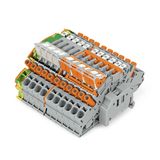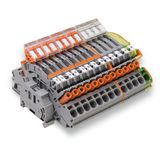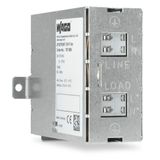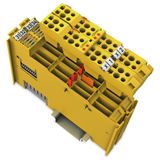WAGO Motor Controls and Drives







When you standardize a plant or building line, the control platform has to cover feeders, motion, and safety without fragmenting accessories. Below is a practical, B2B-focused map of families, sizes, and how they fit together so installers don’t improvise on the backplate.
wago control gear range and platform logic
Build stations from coordinated DIN-rail modules: contactor feeders up to typical 18.5–30 kW motors, interface relays for PLC outputs, compact power supplies, and surge/EMC hardware that shares the same labeling and test points. Specify wago control gear when you want spring-clamp terminations, finger-safe fronts, and jumper systems that keep assembly time predictable across panels.
wago contactors and relays motor duty and interface tiers
AC-3 contactors sized by Ie and utilization category sit beside soft-starters and drives, while plug-in relay interfaces handle 24 V DC/230 V AC I/O with LED and test lever options. Coil suppressors protect outputs; mechanical interlocks cover reversing. Choose auxiliary blocks with mirror contacts where safety relays supervise; use wago contactors and relays when you need consistent terminal geometry and probe-friendly test tabs.
wago automation components PLC, I O, and HMI alignment
PFC-class controllers, edge-capable CPUs, and modular I/O (digital, analogue, RTD, safety) land on the same rail as pilot devices and feeders. Web-visualization HMIs share power and labeling, and ready-made cordsets reduce field crimping. Specify wago automation components so the controller, I/O slices, and front-of-door operators follow one accessory set and one documentation style.
wago industrial control gear environments and finishes
Panels live in very different worlds: HVAC rooms, washdown bays, coastal yards. Use sealed fronts, HDG brackets, and stainless fixings where cleaning or salt is routine; keep EMC shield clamps near gland plates; reserve IP20 interiors for conditioned spaces. Call out wago industrial control gear when the build standard requires corrosion discipline, short earth paths, and predictable thermal behavior.
wago electrical control panels door hardware and layout discipline
Keep 22 mm operators, legend carriers, and E-stops aligned with rail hardware so labels, probe ports, and wire markers are identical from cell to cell. Separate SELV and mains with divider plates; maintain service loops and Ø68/60 mm device geometry where applicable. Choose wago electrical control panels to ensure the door kit, terminal rows, and feeders share clamp ranges and torque values that crews already know.
wago power distribution control feeders, PSUs, and protection
Dimension feeders by installation method and ambient: fine-stranded conductors at 90 °C insulation, compact PSUs with DC-OK contacts, MCB/MCCB coordination, and Type 2 surge stages at sub-boards. Publish busbar and jumper rules so parallel supplies and redundancy diodes don’t surprise service teams. Deploy wago power distribution control when distribution, monitoring, and signaling need one ecosystem from intake to 24 V rails.
wago control equipment accessories, labeling, and serviceability
Padlock hasps for LOTO, test plugs, cross-connect jumpers, shield clamps, and QR-readable marker strips keep audits simple and swaps fast. Choose drawer fuse carriers with blown-link indication where downtime costs bite, and standardize gland threads and compression ranges. Select wago control equipment to keep spares tight and method statements identical across sites.
Technical specifications and standards that matter
Voltage classes up to 690 V for feeders; coils in common 24 V DC/230 V AC variants; terminals sized to 0.5…10 mm² fine-strand; IP20 fronts for rail devices; EMC practice with 360° shield bonds at gland plates; IEC 60947 coordination for contactors, short-circuit data published; EN 60204 and EN 61439 considerations for panel builds; thermal rise limits respected with derating above 40–45 °C enclosure ambient.
Applications and compatibility
- Packaging and motion cells: reversing/soft-start contactor groups, safety-rated feedback contacts, I/O slices for encoders and valves, HMI for recipes and alarms.
- Utilities and HVAC: pump handover logic, PLC with web HMI, PSUs with DC-OK to BMS, surge protection on floor boards.
- Food, pharma, coastal: sealed operators, stainless fixings, HDG support steel, solvent-resistant markers, and tidy shield terminations.
Integration with other brand products
Pair DIN-rail terminal rows, shield clamps, and power supplies from the same ecosystem so conductor sizes and ferrule policies match. Field cabling in LSZH or PUR routes through compression glands sized to jacket OD; pre-terminated M12 sets land on distributed I/O without adapters; patch the HMI to plant networks with disciplined 360° bonds.
Selection criteria for B2B clients
- Define loads and duty motor Ie, AC-3 category, inrush behavior for contactor/relay choice.
- Fix control architecture PLC/I/O footprint, HMI size, and protocol set; reserve DIN real estate accordingly.
- Set environment policy finish (pre-galv/HDG/A2/A4), IP needs, and washdown/UV rules.
- Coordinate protection MCCB/MCB curves, fuse backup where needed, SPD stack and bonding path.
- Document wiring conductor class, shield strategy, gland threads/torque, and test points; align labels with your QA templates.
Advantages of working with Bankoflamps
Your procurement flow stays practical for build shops: tailored B2B pricing with custom quotes, managed by a named account manager who learns your standards. Quote turnarounds are typically ~1 hour, and ordering by EAN/MPN keeps drawings and purchase lines synchronized. The portal gives real-time EU warehouse stock, lead-time and order-status tracking, and downloadable price lists that are kept current; purchase history with analytics supports repeat panels and forecasting. Trusted customers can operate with post-payment up to 30 days. We cut freight by consolidating consignments, keep prices valid for stated windows, and supply teams in France, the Baltics, Germany, Spain, Italy, Belgium, and the Netherlands.